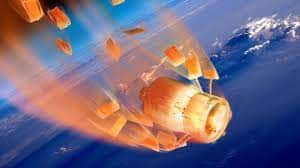What’s in today’s article?
- Why in News?
- What Happens to Satellites after their Life ends?
- How ISRO Brought Down the Satellite?
- Why did ISRO Attempt a Controlled Re-entry?
Why in News?
- The Indian Space Research Organisation (ISRO) for the first time brought down a satellite – Megha Tropiques-1, in a controlled manner after its end of life.
- Although the mission life of the weather satellite – a joint India-France mission launched aboard a PSLV in 2011, was only 3 years, it continued providing data on water cycle, energy exchanges in the tropics for nearly a decade.
What Happens to Satellites after their Life ends?
- Usually, satellites are left in their orbit and because of the gravitational pull of the earth, they come down to the atmosphere over years and years.
- It takes debris from the low earth orbit 20 to 30 years to fall to the atmosphere and generations for those in geosynchronous or geo-stationary orbits to fall.
- When the satellites re-enter the atmosphere, the friction causes it to heat up to extreme high temperatures of thousands of degrees Celsius.
- Without a heat shield, 99% of a satellite gets burnt up whether in a controlled re-entry or an uncontrolled one.
- A controlled re-entry is possible only for satellites in low-earth orbit – at about 1,000 kms over the surface of the earth.
- These manoeuvres, however, are not usually attempted because fuel reserves have to be maintained in the satellite after mission life is over.
- This is impossible for satellites placed in geo-stationary or geosynchronous orbit – where time taken by the satellite to orbit the earth matches Earth’s rotation – because they are at altitudes of nearly 36,000 kms.
- For attempting to bring down a satellite from such an orbit, a huge fuel reserve would be needed, which will only make the satellite heavier and costlier at launch.
- Therefore, instead of bringing them down, they are shot upwards at the end of life. These orbits are like parking lots in space where all old satellites are put in.
- Sometimes a satellite might escape to deep space (when its velocity increases enough to get away from the gravitational pull of the earth) as well.
How ISRO Brought Down the Satellite?
- This was the first time that the space agency attempted such a manoeuvre to clear out space debris despite the satellite not being built to do so.
- With over 120kgs of fuel remaining in the satellite even after being decommissioned, the space agency attempted a controlled re-entry.
- A series of 20 manoeuvres over eight months lowered the orbit of the satellite such that it re-entered the dense atmosphere and burnt up over the Pacific Ocean.
Why did ISRO Attempt a Controlled Re-entry?
- Other than extra fuel remaining in the satellite after the mission life ended, ISRO attempted the control re-entry to demonstrate and understand the process of doing so.
- With several satellites/other objects/debris moving at extremely high speeds in low earth orbits, it has become imperative to keep the space clean as even the smallest debris can destroy active satellites.
- Kessler syndrome – a scenario where the amount of space debris reaches a point where they just create more with one collision triggering others – is even scarier.
- This is the reason space debris is monitored and sometimes satellites have to be moved from their way.
- For example, ISRO carried out 21 such collision course manoeuvres in 2022 and set up a department last year to monitor the space debris and mitigate the risks posed.
- The space agency was also following the guidelines of UN and the Inter-Agency Space Debris Coordination Committee (IADC) that say satellites should be deorbited after mission life.
Image Caption: Space Junk by Numbers
Q1) What is Megha-Tropiques-1 (MT1)?
It was a satellite launched in 2011, as a collaborative effort between ISRO and the French space agency CNES for carrying out tropical weather and climate studies. The controlled re-entry experiment for the decommissioned MT-1 was carried out successfully recently.
Q2) What is IS4OM?
ISRO System for Safe and Sustainable Space Operations Management (IS4OM) is a holistic approach launched in response to ever-growing space object population and the risk of collisions in space and undertakes observation and monitoring of space objects and space environment.
Source: Isro brings down decommissioned weather satellite: What is a controlled re-entry? Why is it done? | IE
Last updated on December, 2025
→ Check out the latest UPSC Syllabus 2026 here.
→ Join Vajiram & Ravi’s Interview Guidance Programme for expert help to crack your final UPSC stage.
→ UPSC Mains Result 2025 is now out.
→ UPSC Notification 2026 is scheduled to be released on January 14, 2026.
→ UPSC Calendar 2026 is released on 15th May, 2025.
→ The UPSC Vacancy 2025 were released 1129, out of which 979 were for UPSC CSE and remaining 150 are for UPSC IFoS.
→ UPSC Prelims 2026 will be conducted on 24th May, 2026 & UPSC Mains 2026 will be conducted on 21st August 2026.
→ The UPSC Selection Process is of 3 stages-Prelims, Mains and Interview.
→ UPSC Result 2024 is released with latest UPSC Marksheet 2024. Check Now!
→ UPSC Prelims Result 2025 is out now for the CSE held on 25 May 2025.
→ UPSC Toppers List 2024 is released now. Shakti Dubey is UPSC AIR 1 2024 Topper.
→ UPSC Prelims Question Paper 2025 and Unofficial Prelims Answer Key 2025 are available now.
→ UPSC Mains Question Paper 2025 is out for Essay, GS 1, 2, 3 & GS 4.
→ UPSC Mains Indian Language Question Paper 2025 is now out.
→ UPSC Mains Optional Question Paper 2025 is now out.
→ Also check Best IAS Coaching in Delhi

















